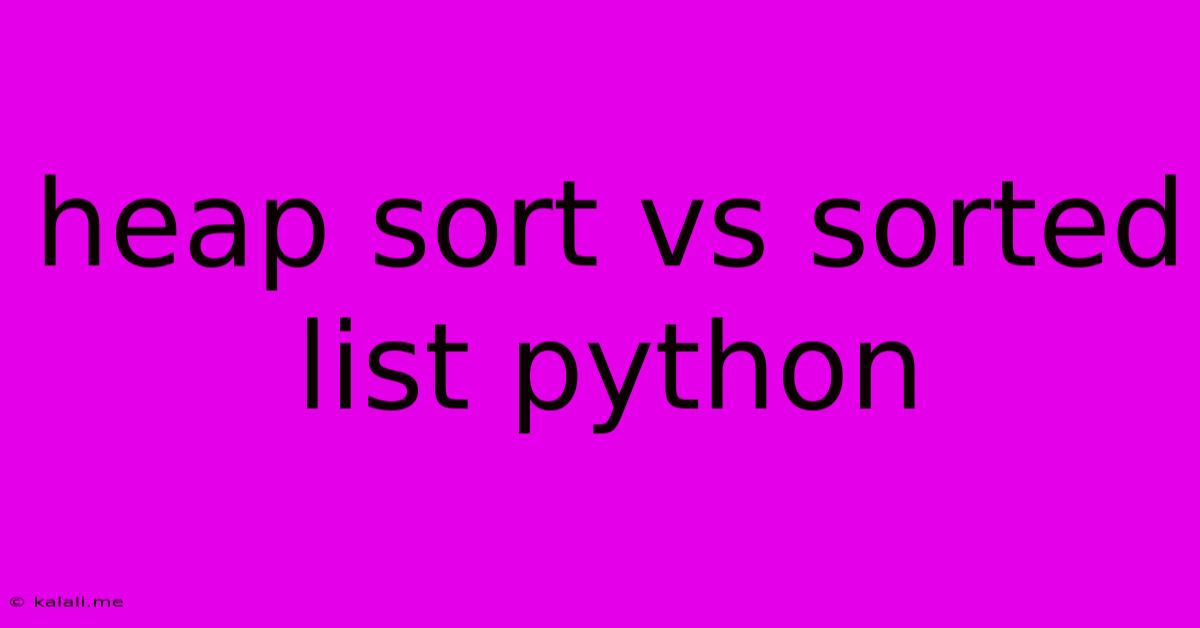Heap Sort Vs Sorted List Python
Kalali
May 31, 2025 · 3 min read

Table of Contents
Heap Sort vs. Sorted List in Python: A Performance Comparison
Choosing the right data structure and algorithm is crucial for efficient Python programming. When dealing with large datasets that require sorting, two common approaches stand out: using Python's built-in sorted() function (often leveraging Timsort) which implicitly uses a sorted list, and implementing a heap sort algorithm. This article delves into a performance comparison of these two methods, highlighting their strengths and weaknesses to help you make informed decisions for your projects. We'll explore the complexities, practical applications, and real-world scenarios where one method might outperform the other.
What are we comparing?
We're comparing the performance characteristics of two distinct approaches to sorting in Python:
-
sorted()function (implicitly using a sorted list): Python's built-insorted()function is highly optimized and generally provides excellent performance for a wide range of data sizes and types. It's often based on Timsort, a hybrid sorting algorithm known for its efficiency. This approach builds a new sorted list. -
Heap Sort: This is a comparison-based sorting algorithm that uses a binary heap data structure. It's known for its guaranteed O(n log n) time complexity, even in the worst-case scenario, making it a reliable choice for large datasets. This approach sorts the data in place, meaning it modifies the original list.
Time Complexity Analysis:
-
sorted()(Timsort): Offers an average and best-case time complexity of O(n log n). In the worst case, it can degrade to O(n^2), but this is rare in practice. -
Heap Sort: Consistently delivers O(n log n) time complexity for all cases (best, average, and worst).
Space Complexity Analysis:
-
sorted(): Has a space complexity of O(n) because it creates a new sorted list. This can be a significant drawback for extremely large datasets where memory is a constraint. -
Heap Sort: Offers an in-place sorting approach with O(1) auxiliary space complexity. This makes it memory-efficient, especially beneficial when dealing with massive datasets that might exceed available RAM.
Practical Considerations and Use Cases:
-
sorted(): Ideal for situations where:- Simplicity and ease of use are prioritized.
- Memory is not a significant constraint.
- You need a new sorted list, rather than modifying the original.
- You're working with smaller to medium-sized datasets.
-
Heap Sort: Best suited for scenarios where:
- Memory efficiency is paramount. This is crucial for very large datasets.
- Guaranteed O(n log n) time complexity is essential, regardless of the input data.
- Sorting in-place is preferred to avoid the overhead of creating a new list.
Python Code Example (Illustrative):
This code snippet is for illustrative purposes; for rigorous benchmarking, consider using the timeit module with a larger, more representative dataset.
import heapq
import random
# Generate a large list of random numbers
data = [random.randint(1, 100000) for _ in range(10000)]
# Using sorted()
sorted_data = sorted(data)
# Using Heap Sort (implementation omitted for brevity – readily available online)
heap_sorted_data = heap_sort(data.copy()) #Important: use a copy to avoid modifying original data
# (Verification – compare results. Omitted for brevity.)
Conclusion:
The choice between using Python's sorted() function and implementing a heap sort hinges on your specific needs. For most everyday tasks involving smaller to medium-sized datasets, sorted() is often sufficient due to its simplicity and generally excellent performance. However, when dealing with massive datasets where memory is a limiting factor, or when a guaranteed O(n log n) time complexity is critical regardless of input order, a heap sort implementation provides a significant advantage due to its in-place sorting and consistent performance. Remember to profile your code with realistic data to determine the most efficient approach for your particular application.
Latest Posts
Latest Posts
-
Why Is My Car Sputtering When I Accelerate
Jun 01, 2025
-
Can You Have Multiple Gfci Outlets On The Same Circuit
Jun 01, 2025
-
How Much Does A Engine Weigh
Jun 01, 2025
-
How Do You Become A Guard In Squid Game
Jun 01, 2025
-
What Does Rtd Mean On Plywood
Jun 01, 2025
Related Post
Thank you for visiting our website which covers about Heap Sort Vs Sorted List Python . We hope the information provided has been useful to you. Feel free to contact us if you have any questions or need further assistance. See you next time and don't miss to bookmark.